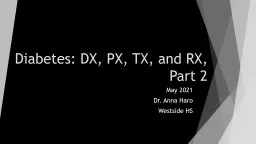

August 2021 Dr Anna Haro Westside HS LEARNING Objectives TEKS 130231 c 1A amp B and 130231 c 2A B C F amp G amp 3B Students will apply previous knowledge of human and cellular biology ID: 912981
Download Presentation The PPT/PDF document "Musculoskeletal Part 1 – the Bones" is the property of its rightful owner. Permission is granted to download and print the materials on this web site for personal, non-commercial use only, and to display it on your personal computer provided you do not modify the materials and that you retain all copyright notices contained in the materials. By downloading content from our website, you accept the terms of this agreement.
Slide1
MusculoskeletalPart 1 – the Bones
August 2021
Dr. Anna Haro
Westside HS
Slide2LEARNING Objectives
TEKS:
§130.231.(c)(1)(A, & B) and §130.231.(c)(2)(A, B, C, F, & G) & (3)(B)
Students will apply previous knowledge of human and cellular biology.
Students will identify the main anatomic features of the skeletal system, the bones.
Students will explain the function and physiology of bones.
Students will create a drawing model of the human skeleton.
Slide3Objetivos de aprendizaje
TEKS: §130.231.(c)(1)(A, & B) and §130.231.(c)(2)(A, B, C, F, & G) & (3)(B)
Los estudiantes aplicarán conocimientos previos de biología humana y celular.
Los estudiantes identificarán las principales características anatómicas del sistema esquelético, los huesos.
Los estudiantes explicarán la función y fisiología de los huesos. Los estudiantes crearán un modelo de dibujo del esqueleto humano.
.
Slide4Anatomy
The skeletal system or bones create the body’s central framework.
There are ____________ bones in the human body.The skeletal system consists of bones and connective tissue, including cartilage, tendons, and ligaments. It’s called the musculoskeletal system in the medical profession and includes the muscles. (First, we will focus on the bones.)
Slide5Anatomy – types of bones
The
bones are classified by shape:Long bones are long and thin. They support the body’s weight and movement. (ex. femur, radius, ulna)Short bones are cube-like shape, about as wide as they are long. They provide stability and some movement. (ex. carpals and tarsals of wrist and ankle)
Flat bones
are varying length, but flat like a shield. They are used for protection of the body’s inner organs. (ex. sternum, rib cage, multiple cranial bones)
Slide6Anatomy – types of bones continued
Sesamoid bones
are round and embedded in tendons to protect tendons from repetitive movements (ex. patella or the “knee cap”)Irregular bones do not have a specific shape/structure and are categorized separately. Their complex shape helps protect internal organs. (ex. vertebral bones protect the spinal cord, pelvic bones protect reproductive structures)
Slide7Anatomy – types of bones continued
Slide8What is a bone?
There are _________ types of bone tissue:
periosteum, compact bone, and spongy bone.The periosteum is a hard, but thin layer that surrounds and protects your bones.Compact bone
is hard, dense, and smooth. Approximately 80% of the bone anatomy is compact bone. It consists of calcium, phosphorous, and a protein network to give bones strength and structure.
Discussion question: How strong is calcium? In nature, do you know of other structures that are composed of calcium or calcium carbonate?
Slide9What is a bone made of?
Spongy bone
is soft, porous (it has holes), and is rich in blood vessels. Spongy bone forms the core and is the inner layer of bone. Spongy bone consists of red marrow and yellow marrow. (Red marrow is usually located in the flat bones vs. yellow marrow found in long bones.) The marrow or bone marrow is where red blood cells, platelets, and some WBC are created.
Spongy bone
makes and repairs compact bone and the periosteum in event of a fissure or fracture.
Slide10Parts of a bone
Medullary cavity is the inner space of a bone or the very middle of the structure.
Epiphysis – the round and wider ends of a bone, made of spongy bone. More than one epiphysis are called epiphyses. Each long bone has two epiphyses.Epiphysial plate – this is the “growth plate” Diaphysis - the tubular shaft of the bone.
Slide11Bones
Compact bone surrounds the spongy bone.
The bone marrow is contained within the spongy bone.The periosteum is the outer layer of the bone.What else do you see?Medullary cavity is the inner space or the very middle of the structure.Epiphysis – the rounded and wider ends, made of spongy bone.
Diaphysis - the tubular shaft of the bone.
Slide12Physiology (or function) of bones
“Allows movement: Your skeleton supports your body weight to help you stand and move. Joints, connective tissue and muscles work together to make your body parts mobile.
Produces blood cells: Bones contain bone marrow. Red and white blood cells are produced in the bone marrow.Protects and supports organs: Your skull shields your brain, your ribs protect your heart and lungs, and your backbone protects your spine.Stores minerals: Bones hold your body’s supply of minerals like calcium and vitamin D.”
Slide13Questions about bones?
I don’t have most of the answers, but I can help you find the right references.
Remember the HON-code? https://www.hon.ch/HONcode/
Slide14References
https://www.visiblebody.com/learn/skeleton/types-of-bones
https://askabiologist.asu.edu/biology-bits/bone-bits
https://my.clevelandclinic.org/health/body/21048-skeletal-system
Slide15Activity today:***Major grade*** Life-size human skeletons.
Trace and draw a classmate.
Use the internet and classroom posters to draw and label 75 different bones in the human body. No two groups will be the same. Use different colors or patterns to distinguish different bones.
Drawings must include at least two bones of each type (long, short, flat, sesamoid, and irregular).
Do not label both extremities, so only choose the right or left leg/arm and foot/hand).